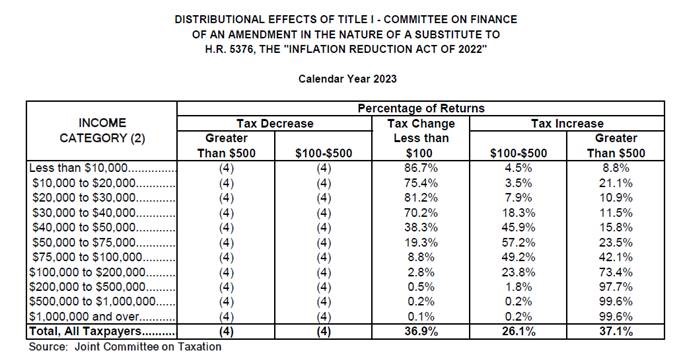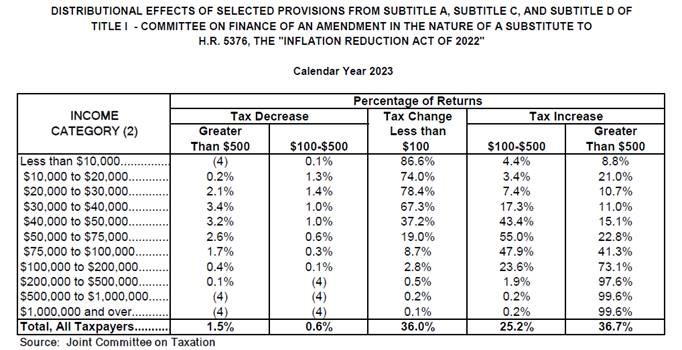JCT Confirms: Tax Costs Exponentially Outweigh Benefits
New analysis shows outsized tax burden over benefit for vast majority of Americans
Washington, D.C.--The nonpartisan Joint Committee on Taxation (JCT) has issued an analysis of effects of the Democrats’ reckless tax-and-spend bill on taxpayers in each income category.
The new analysis shows that the burden of the bill’s tax increases on lower- and middle-income Americans is so great, any supposed benefits from the temporary premium credits only outweigh the tax hits for a small sliver of the population. Even for the small number of people would do receive a slight benefit, significantly larger portions of American taxpayers in each income category would still face the burden of a tax increase.
“The Administration has been very careful to say that the ‘individual income tax rate’ would not change for anyone making less than $400,000 per year, yet everyone knows that the corporate tax burden falls on workers and consumers, as well as owners,” said Senate Finance Committee Ranking Member Mike Crapo (R-Idaho), who requested the analysis. “This analysis shows that burdens of the proposed tax increases in the Democrats’ reckless bill would be so substantial and so widespread throughout all income categories that no amount of temporary health credits, or subsidies for $80,000 luxury SUVs, will overcome the tax increase burdens that would be overwhelmingly felt by lower- and middle-income Americans.”
The analysis of the tax title of the “Inflation Reduction Act of 2022” includes the corporate book minimum tax increase and all energy tax provisions that JCT is able to estimate. It does not include the Superfund tax, the formerly-proposed changes to taxation of carried interest, or a potential excise tax on stock buybacks which would, if included, show even larger burdens on Americans of all income categories.
According to JCT, given the tax hikes and most of the “Green New Deal” tax credits in the Democrats’ reckless tax-and-spend bill:
- In 2023:
- 24.6 percent of taxpayers earning between $10,000 and $20,000 would see a tax increase.
- 61.7 percent of taxpayers earning between $40,000 and $50,000 would see a tax increase.
- 91.3 percent of those earning between $75,000-$100,000 would see a tax increase.
- 97.2 percent of those earning between $100,000-$200,000 would see a tax increase.
- By 2031, long after the expiration of temporary Obamacare tax credit subsidies:
- 71.1 percent of taxpayers earning between $20,000 and $30,000 will face the burden of a tax increase.
- 81.4 percent of those earning between $75,000 to $100,000 will face a tax increase of more than $500.

Although not part of the tax title in the “Inflation Reduction Act,” Ranking Member Crapo also requested for the JCT to analyze Democrats’ proposed tax title with the three-year extension of the expanded Affordable Care Act premium subsidies. The results of that analysis show that even when those subsidies are factored in, tax burdens from the Democrats’ bill on low- and middle-income Americans significantly outweigh any tax and ACA-premium benefits.
- In 2023, the first of three years the extended ACA credit is in effect:
- Only 3.2 percent of those with income between $50,000 and $75,000 get a tax cut (all from the premium credit), while nearly 78 percent of those in that income category get a tax increase.
- Only 2.0 percent of those earning between $75,000 and $100,000 receive a tax cut, while 89.2 percent will get a tax increase.
- Only 0.5 percent of those between $100,000 and $200,000 get a tax cut, while 96.7 percent get a tax increase, with 73.1 percent of them getting a tax increase of more than $500.
- In the years following 2025, when the Obamacare subsidies sunset, JCT’s analysis shows that no taxpayers get a tax cut, with the vast majority of taxpayers bearing significant tax increases.
- In 2031, for example, more than 70 percent of taxpayers earning between $20,000 and $30,000 are facing a tax increase.

Background:
Corporate tax increases get passed on to workers in the form of lower wages and to consumers in the form of higher product prices. A recent National Bureau of Economic Research study, for example, estimates 31 percent of a tax hike is borne by consumers via higher prices; 38 percent is borne by workers via lower wages; and 31 percent is borne by owners, who include retirees and current workers building their retirement nest eggs.
Last week, Ranking Member Crapo also released a distributional analysis from the non-partisan JCT showing that the Democrats’ tax and spend bill would increase the tax burden on Americans earning less than $200,000 by nearly $17 billion in the next year alone, with the average tax rate increasing for nearly all taxpayers and with an even greater share of the burden facing those earning below $400,000 as things move through the full 10-year budget period.
Next Article Previous Article
